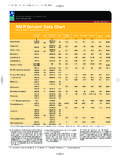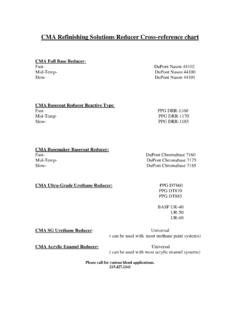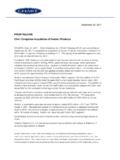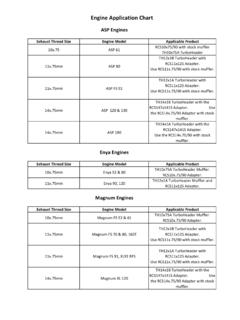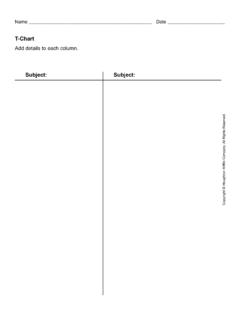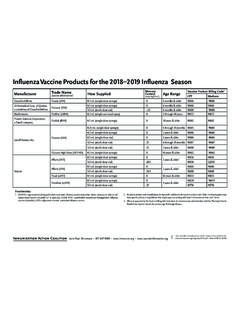Transcription of RESEARCH PRODUCTS NMR Solvent Data Chart
1 LThe 1H spectra of the residual protons and 13C spectrawere obtained on a Varian Gemini 200 spectrometerat 295 K. The NMR solvents used to acquire thesespectra contain a maximum of and TMS(v/v) respectively. Since deuterium has a spin of 1,triplets arising from coupling to deuterium have theintensity ratio of 1:1:1. m denotes a broad peak withsome fine structures. It should be noted that chemicalshifts can be dependent on Solvent , concentrationand values only, may vary with pH, concen-tration and and boiling points are those of the corre-sponding unlabeled compound (except for D2O).
2 These temperature limits can be used as a guide todetermine the useful liquid range of the gathered from the Merck Index Fourteenth Edition. *HOD Peaks - NMR spectra of neat deuterated Solvent always exhibit a peak due to H20 in addition to the residual Solvent peak. When the exchange rate between H20 and HDO is slow on the NMR timescale the water peak appears as two peaks, a singlet corresponding to H20 and a 1:1:1 triplet corresponding to O Neil, Heckelman, Koch, Roman, TheMerck Index, an Encyclopedia of Chemicals, Drugs, and Biologicals Fourteenth Edition, Merck Co.
3 , Inc. Whitehouse Station, NJ Isotope Laboratories, PRODUCTSNMR Solvent data Chart More solvents , More Sizes, More Solutions1 HChemical Shift(ppm from TMS)(multiplicity)JHD(Hz)13 CChemical Shift(ppm from TMS)(multiplicity)JCD(Hz)1H Chemical Shift of HOD(ppm from TMS)Density at 20 CMelting point( C)Boiling point( C)DielectricConstantMolecular WeightAcetic (1) (5) (1) (7) (5) (1) (7) * (5) (1) (7) * (1) (3) (1) (3) * (1) (5) Deuterium (DSS) (TSP) , (1) (3) (5) (7) (5) (7) (5) (7)
4 * , (m) (5) (1) (1) (5) (m) (7) (1) (5) (7) (3) (5) (1) (3) (1) (3) (1) (3)251,1,2, (3) (1) (5) (1) (5) (1) (m) (3) (1) (3) (5) (3) (5) (7)19 Trifluoroacetic (1) (4) (4) (1) (4) (4x3)2(9) (4x5)22uuquullTo place an order please contact CIL: t: ( ) NMR Chart R2-orange 5/27/10 1:21 PM Page 1 Cambridge Isotope Laboratories, Inc. l note that some packaging sizes of some solvents may require special handling not givenbelow. The bottle or ampoule packaging information should be reviewed for further Solvent Storage andHandling InformationAcetic Acid-d4/Acetone-d6/Benzene-d6/Cyclohexan e-d12 /Deuterium Oxide / N,N-Dimethylformamide-d7/Dimethyl Sulfoxide-d6/1,4-Dioxane-d8(p-Dioxane) / Ethanol-d6/ Methanol-d4/ Methylene Chloride-d2/ Pyridine-d5/ 1,1,2,2 Tetrachloroethane-d2/Toluene-d8/ Trifluoroacetic Acid-d / 2,2,2-Trifluoroethanol-d3 Store at room temperature away from light and moisture.
5 The above PRODUCTS are stable if stored under recommended at room temperature away from light and moisture. This product is stable for one year after receipt of order if stored under above conditions (unopened). After one year, the Solvent should be re-analyzed for chemical purity before / Tetrahydrofuran-d8 Store refrigerated (-5oto 5oC) away from light and moisture. These PRODUCTS are stable for six months after receipt of order if stored under above conditions (unopened). After six months, the Solvent should be re-analyzed for chemical purity before Exchange of Labile Protons in Deuterated solvents containing Residual D2 OSome deuterated solvents are prepared by catalytic exchange of protonated Solvent with deuterium oxide and carefully purified bydistillation.
6 Residual water (H2O in equilibrium exchange with D2O) is kept to a minimum of 20-200 ppm, the higher value correspondsto the amount in the more hygroscopic solvents . The labile deuterons (and protons) of water are available to exchange with labileprotons in the chemist's sample and can result in inaccurate integration ratios. The example below shows that just 100 ppm of D2O cancause problems when studying dilute solutions of analytes. A significant decrease in the integral of 1 labile proton may be observedin a sample containing 5 mg organic compound, MW~200, dissolved in 1g DMSO-d6containing 100 ppm D2O.
7 The problem becomesworse as the molecular weight of the analyte increases. Solution Water (as H2O, HDO or D2O) can be minimized by adding molecular sieves to the Solvent , agitating the mixture and allowing it to stand for a few hours. The water content may be reduced to about 10-20 ppm in this manner. If exchange still causes a problem, it isrecommended to use a less hygroscopic Solvent , such as chloroform, methylene chloride or acetonitrile. Figure 1-1H NMR spectrum of mg 2,6-di-tert-butyl-4-methylphenol (MW ) in dry the proper integral ratios of 18:3:1:2 (t-butyl: methyl: ring-H: -OH).
8 Note the single H2O peak at 2- 1H NMR spectrum of mg of 2,6-di-tert-butyl-4-methylphenolin DMSO-d6with 100 ppm D2O the reduced ratio of the phenolicproton 18:3:2 (t-butyl: methyl: ring-H: -OH). Note that the HOH and HODpeaks are separated in the *X residual Solvent ; residual water Cambridge Isotope Laboratories, Inc. 50 Frontage Road, Andover MA 01810ph: ph: ( ) fax: email: NMR Chart R2-orange 5/27/10 1:21 PM Page 2
